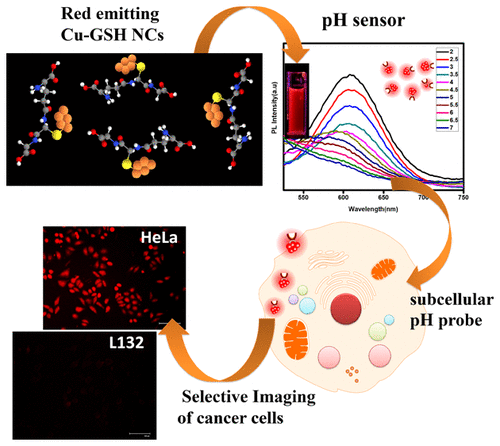当前位置:
X-MOL 学术
›
ACS Appl. Bio Mater.
›
论文详情
Our official English website, www.x-mol.net, welcomes your
feedback! (Note: you will need to create a separate account there.)
Label Free, Nontoxic Cu-GSH NCs as a Nanoplatform for Cancer Cell Imaging and Subcellular pH Monitoring Modulated by a Specific Inhibitor: Bafilomycin A1
ACS Applied Bio Materials ( IF 4.6 ) Pub Date : 2020-01-30 , DOI: 10.1021/acsabm.9b01036 Neeli Chandran 1 , Prajit Janardhanan 2 , Manikanta Bayal 1 , Unnikrishnan Unniyampurath 3 , Rajendra Pilankatta 2 , Swapna S Nair 1
ACS Applied Bio Materials ( IF 4.6 ) Pub Date : 2020-01-30 , DOI: 10.1021/acsabm.9b01036 Neeli Chandran 1 , Prajit Janardhanan 2 , Manikanta Bayal 1 , Unnikrishnan Unniyampurath 3 , Rajendra Pilankatta 2 , Swapna S Nair 1
Affiliation

|
Metal nanoparticles-based sensors invoked much research attention in the biomedical field, especially in applications involving live cell imaging and monitoring. Here, a simple cost-effective method is adopted to synthesize glutathione coated copper nanoclusters (Cu-GSH NCs) with strong bright red fluorescence (625 nm). The clusters were found to be containing five Cu(0) atoms complexed with one molecule of glutathione (GSH) as evidenced by MALDI-TOF MS analysis. The synthesized Cu-GSH NCs system responds linearly to the pH in the acidic and alkaline ranges with a high degree of in vitro pH reversibility, projecting its potential as a real time pH sensor. Higher intensity emission observed in acidic conditions can be exploited for its employability as cellular organelle markers. The imaging and sensing potential of Cu-GSH NCs in the live human adenocarcinoma cell line, the HeLa cells, was tested. The treatment of HeLa cells for 48 h imparted deep red fluorescence, owing to the lower level of intracellular pH in cancer cells. In contrast, the imaging using normal cell lines (L-132, lung epithelial cell line) showed significantly lower fluorescence intensity as compared to that of HeLa cells. The subcellular pH-dependent fluorescence emission of Cu-GSH NCs was further assessed by treating HeLa cells with proton pump (V-ATPase) inhibitor Bafilomycin A1, which increases the vesicular pH. Interestingly, the fluorescent intensity of HeLa cells decreases with increasing concentration of Bafilomycin A1 in the presence of Cu-GSH NCs, as evidenced by the fluorescence microscopic images and quantitative fluorescent output. Accordingly, the developed Cu-GSH NCs system can be employed as an efficient pH-based bioimaging probe for the detection of cancer cells with an implied potential for the label free subcellular organelle tracking and marking. Importantly, the Cu-GSH NCs can be used for live cell pH imaging owing to their high degree of reversibility in sensing of pH variation.
中文翻译:

无标签、无毒的 Cu-GSH NCs 作为癌细胞成像和亚细胞 pH 监测的纳米平台,由特定抑制剂调节:巴弗洛霉素 A1
基于金属纳米粒子的传感器在生物医学领域引起了很多研究关注,特别是在涉及活细胞成像和监测的应用中。在这里,采用一种简单的成本效益高的方法来合成具有强亮红色荧光(625 nm)的谷胱甘肽涂层铜纳米簇(Cu-GSH NCs)。MALDI-TOF MS 分析证明,这些簇含有五个与一分子谷胱甘肽 (GSH) 复合的 Cu(0) 原子。合成的 Cu-GSH NCs 系统在酸性和碱性范围内对 pH 值呈线性响应,具有高度的体外 pH 可逆性,显示出其作为实时 pH 传感器的潜力。在酸性条件下观察到的更高强度发射可用于作为细胞器标记物。测试了 Cu-GSH NCs 在活人腺癌细胞系 HeLa 细胞中的成像和传感潜力。由于癌细胞中细胞内 pH 值较低,处理 HeLa 细胞 48 小时会产生深红色荧光。相比之下,与 HeLa 细胞相比,使用正常细胞系(L-132,肺上皮细胞系)的成像显示出显着较低的荧光强度。通过用质子泵 (V-ATPase) 抑制剂 Bafilomycin A1 处理 HeLa 细胞来进一步评估 Cu-GSH NCs 的亚细胞 pH 依赖性荧光发射,这会增加囊泡的 pH 值。有趣的是,在存在 Cu-GSH NCs 的情况下,HeLa 细胞的荧光强度随着 Bafilomycin A1 浓度的增加而降低,荧光显微图像和定量荧光输出证明了这一点。因此,开发的 Cu-GSH NCs 系统可用作有效的基于 pH 值的生物成像探针,用于检测癌细胞,具有无标记亚细胞器跟踪和标记的潜在潜力。重要的是,Cu-GSH NCs 可用于活细胞 pH 成像,因为它们在感知 pH 变化方面具有高度的可逆性。
更新日期:2020-01-31
中文翻译:

无标签、无毒的 Cu-GSH NCs 作为癌细胞成像和亚细胞 pH 监测的纳米平台,由特定抑制剂调节:巴弗洛霉素 A1
基于金属纳米粒子的传感器在生物医学领域引起了很多研究关注,特别是在涉及活细胞成像和监测的应用中。在这里,采用一种简单的成本效益高的方法来合成具有强亮红色荧光(625 nm)的谷胱甘肽涂层铜纳米簇(Cu-GSH NCs)。MALDI-TOF MS 分析证明,这些簇含有五个与一分子谷胱甘肽 (GSH) 复合的 Cu(0) 原子。合成的 Cu-GSH NCs 系统在酸性和碱性范围内对 pH 值呈线性响应,具有高度的体外 pH 可逆性,显示出其作为实时 pH 传感器的潜力。在酸性条件下观察到的更高强度发射可用于作为细胞器标记物。测试了 Cu-GSH NCs 在活人腺癌细胞系 HeLa 细胞中的成像和传感潜力。由于癌细胞中细胞内 pH 值较低,处理 HeLa 细胞 48 小时会产生深红色荧光。相比之下,与 HeLa 细胞相比,使用正常细胞系(L-132,肺上皮细胞系)的成像显示出显着较低的荧光强度。通过用质子泵 (V-ATPase) 抑制剂 Bafilomycin A1 处理 HeLa 细胞来进一步评估 Cu-GSH NCs 的亚细胞 pH 依赖性荧光发射,这会增加囊泡的 pH 值。有趣的是,在存在 Cu-GSH NCs 的情况下,HeLa 细胞的荧光强度随着 Bafilomycin A1 浓度的增加而降低,荧光显微图像和定量荧光输出证明了这一点。因此,开发的 Cu-GSH NCs 系统可用作有效的基于 pH 值的生物成像探针,用于检测癌细胞,具有无标记亚细胞器跟踪和标记的潜在潜力。重要的是,Cu-GSH NCs 可用于活细胞 pH 成像,因为它们在感知 pH 变化方面具有高度的可逆性。

































 京公网安备 11010802027423号
京公网安备 11010802027423号